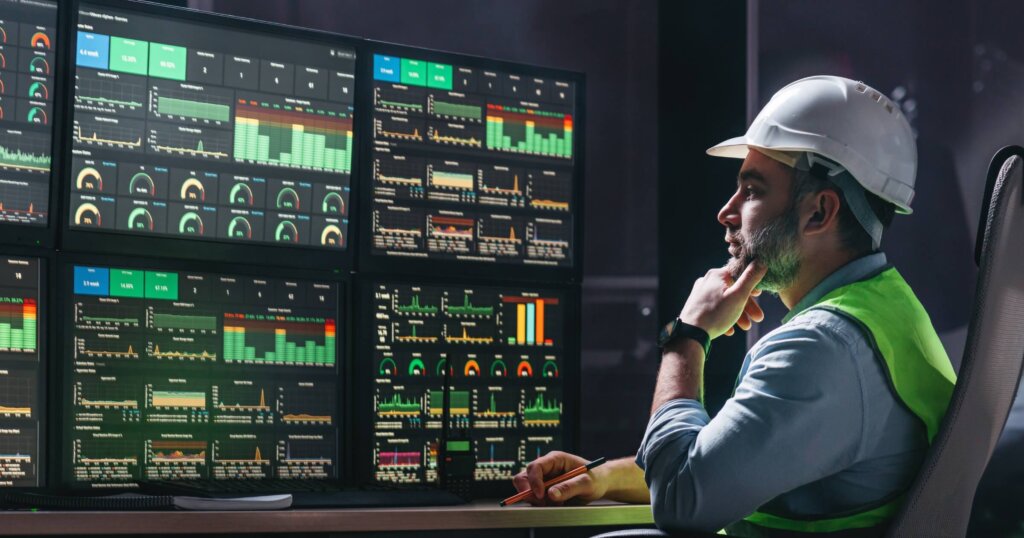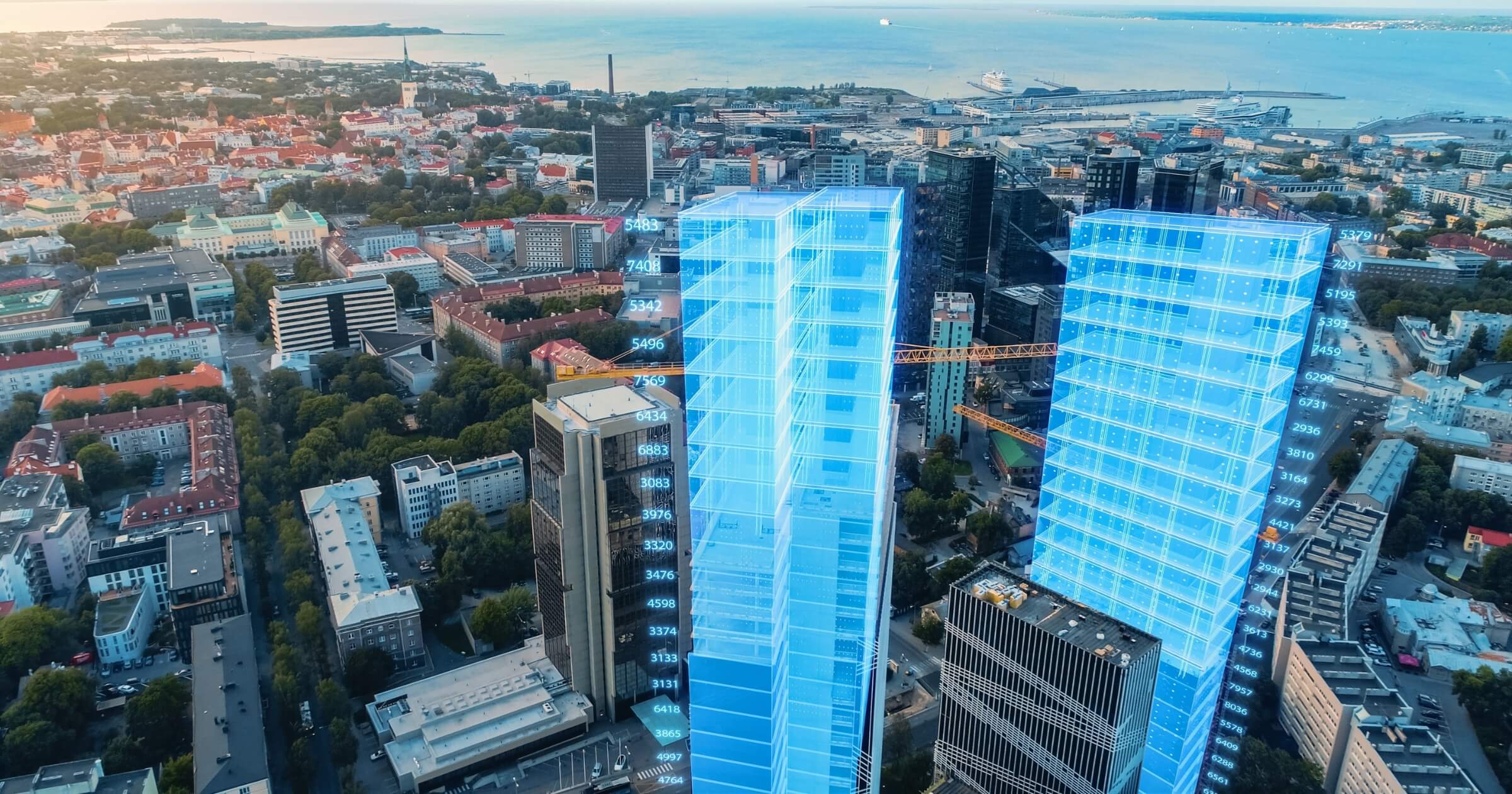What was once a casual conversation about a new tool called ChatGPT is now a technology that’s sweeping through every industry, including construction. With AI, software platforms and apps can execute some of the tasks that traditionally require human expertise, like research, prioritization, problem-solving, and strategizing. The AI upswing started with email drafting and chatbots, but in the construction industry, it’s evolved to simplify project management, design development, bidding and estimation, collaborative robotics, and more.
The global market for AI use in construction is growing
A recent research study from Blubeam concluded that the construction, lifecycle planning, and design phases have one of the highest technology adoption rates at almost 80%.
The study also notes that its implementation is more apparent in software use and scaling applications and is slower to grow in physical operation contexts. Building information modelling (BIM) and computer-aided design (CAD) are fundamental to the construction industry, and that’s where we see AI most often in practice, with 48% of surveyed firms using it in design. However in an operation and maintenance context, the adoption percentage drops to around 21%.
The research also concluded that some built environment businesses are more heavily investing their IT budgets in AI. Still, roughly a quarter of AEC-related companies say they do not use AI at all.
Since AI is an emerging technology, there’s a lot of hesitation around its use, especially in applications that could impact physical safety. But with slow adoption, monitoring, and improvements, many businesses are integrating AI-powered products to help with predictive maintenance, to help produce more sustainable building materials, and to even do the construction themselves with autonomous machinery.
The benefits of using AI in construction
There are many applications in which AI can benefit the construction industry, and the list of pros only continues to grow. Some of the main benefits AI brings to the space include:
- Job timeline estimations
- Materials estimations
- Quality control
- Scheduling and payment processing
- Site safety enhancement
The main thing AI is currently being used for is taking large quantities of data and producing reports, patterns, forecasting, scheduling, and essentially anything else that would take human hours of manual work.

By being able to synthesize data faster and more accurately, it reduces the chances of construction projects going past their timelines. It also reduces errors and rework, so the human workers can focus on more complicated and strategic priorities.
8 popular use cases of AI in construction
1. Project management
One of the more popular AI applications in construction is with project management. AI can simplify and optimize the allocation of materials and labor, making planning, estimating, and scheduling more efficient and cost-effective.
Behind-the-scenes project management work is integral to every job. Any bumps in the timeline can slow things down, and AI can anticipate issues, reroute work and scheduling, and have the project back on the original timeline. It’s fewer deadlines missed and more reliable project completion.
2. Material resourcing and management
AI also optimized material management and sourcing. Many AI tools can keep more accurate inventory records and predict material demands. This means that for every job your company works on, there’s little worry about materials shortages, causing delays, or over ordering, which is wasteful and eats into your budget.
AI also automates the ordering process, improving logistics, sticking to outlined budgets, and meeting project timelines.
3. Predictive maintenance
Aside from tracking schedules and inventories, AI tooling can also meticulously record machinery and other equipment. Anything from electrical systems to skid steers can be logged, with maintenance records and assessments helping it flag when the next round of preventative maintenance is needed to avoid equipment disruption and failure.
4. Design development
The design development phase is an essential step in construction project development. Here, engineers and architects use modeling software to turn designs into accurate models. In this phase, integral decisions about energy efficiency, cost, functionality, and project execution are made.
AI comes into play by providing modelling and simulations of project designs. It works faster and with more granularity to equip designers with better tools to bring a construction project to life and improve planning and efficiency.
5. Bidding and estimation
When it comes time for estimation and bidding in each construction project, AI can help forecast with better accuracy. Some AI tools automate repeat tasks like takeoffs and improve the analysis of project scope, estimated completion, and required materials.
AI essentially shortens the timeline for making decisions, such as vetting profitable projects. It doesn’t have the final decision-making word, but it allows the right stakeholders to stay involved and be better informed.
6. Collaborative robotics
Robotics is becoming an increasingly popular area of AI construction project execution in recent years. From 3D printed cement work, building envelope installation, and training and simulation, AI in robotics is seeing more use on the frontlines.
Repetitive physical tasks like bricklaying, cement pouring, and welding are common robotics use cases, and as technology advances, we’ll see more AI in physical applications.
7. Internet of things (IoT)
IoT in a construction context involves connecting elements of a construction project to a unified system that coordinates activity execution. This could include anything from personnel to site assessments to equipment materials.
The IoT device contains sensors that collect data like worker health, equipment location, and site safety. This data is then transmitted and analyzed so workers can take action on flagged to-dos and alerts.
8. Safety oversight and risk management
Potentially, the most impactful AI application is its use in the context of safety and risk management. Construction is one of the most dangerous industries out there and causes the most fatalities out of any industry today.
AI comes into the picture with sensors and cameras that can monitor sites for potential safety hazards. They’re often used in pre-inspection, putting the human inspectors at a lesser risk. AI sensors also come in the form of wearables for workers, detecting dangerous situations or flagging concerning health stats on the job.
Is AI the future of construction?
The future of AI in construction requires refining these use cases to make AI adoption more commonplace.
AI in software is becoming more popular each month, and applications in safety, bidding, design, and robotics will become more popular as technology advances, risks decrease, and competitors try to keep up with each other in the market.
Some construction businesses still do not use AI in their organization, and others are quick to stay ahead of the curve with the latest software and tooling. Whether your company is open to it or not, AI isn’t going anywhere. Keeping up with the latest could be the difference between a thriving construction business and one that lags behind.
To stay updated on the latest AI in the AEC space, follow us on LinkedIn and subscribe to the newsletter.


